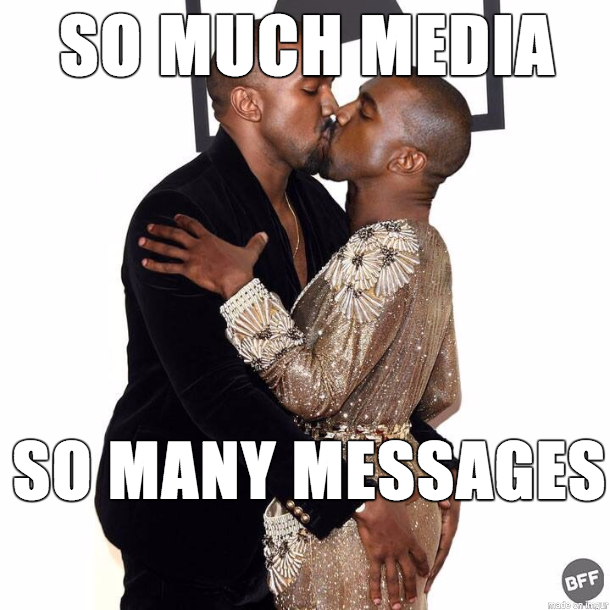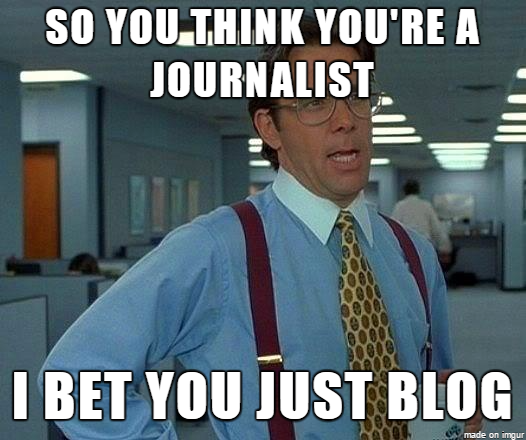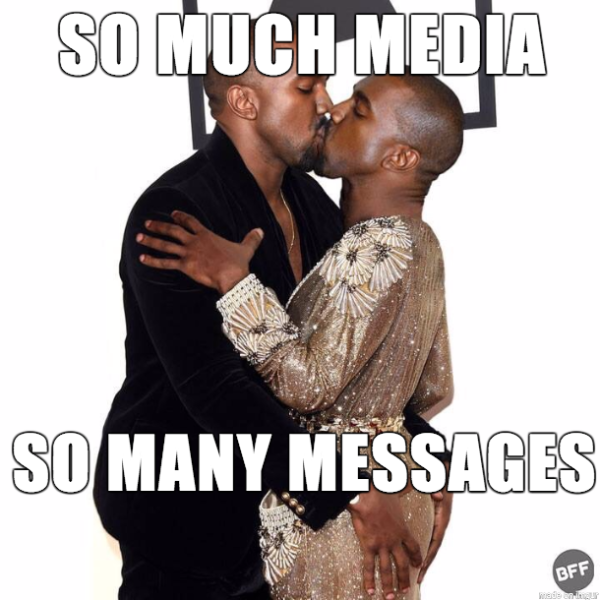The war between the legacy media and the movement for the citizen journalists continues to rage on. As the legacy media accuses the average citizen journalist as being inadequate, pimpled and single, the ever increasing movement retorts with claims of secrecy, bias and hidden agenda. Despite these polarising arguments, I cannot help but think that the ideal solution lends itself to a harmonious relationship. There is strong argument to support both facets of the media as an institution, so why should either be considered wrong. Whilst the ethics and values of the citizen journalist movement may seem overall more beneficial to a democratic society, the practicalities of small time bloggers and website owners do not have the capacity or capability to cover the large scale news. The scale between the legacy media and that of the citizen journalist is large, with much between. With this in mind I suggest there is a middle ground to be found here, and we may be closer to it than the current discussion suggests.
The Remix Age.
It has been said we live in the age of remix, soaked in ‘remix culture’. On the surface this is true. We are surrounded by remixes, collages, fusions and mashups that are created over an infinite amount of media platforms every day. There are examples everywhere in our cultural collective that provide examples supporting the notion of a remix culture. Whilst this in itself is not a negative thing, people are unnerved by what this means for original content and it’s place in modern society. There is argument that original content will always ‘win’ however perhaps it is time to embrace the cultural shift that is being brought by enhanced technology. The concept of a remix does not mean the death of original content. An example of this is the YouTube star Kutiman and his channel ThruYOU who allows people to mix together and record from musicians in Tel Avuv. Gaining over 2 million views in two weeks, Kutiman’s work is described as creating a new vernacular and gives new life to already existing pieces of media. This is an example of the ‘new original’ that appears to be the way of the future.

The wonder of transmedia narratives
The practice of transmedia storytelling is an explosive concept that allows for multifaceted engagement with a foundational story that branches out into other stories. It must be noted that transmedia storytelling is not one story told over many channels but exists as multiple narratives that form a coherent whole, with different points of entry. This has astounding implications for concepts of society and culture as this system dispersal is mutli directional and break downs the traditional concept of ‘borders’. It has a number of positive effects in this regard as it can be used as a tool of empowerment whereby different cultural spins and encourages creative reworking of stories that speak to individuals and their age, culture, socio economic standing etc. However with the beauty of this trend, the flipside is that with this empowerment their is silence from those without access and there is criticism that content can become increasingly westernised.
Where does the physical end and the digital begin?
In this Prezi I have tried to provide a brief snapshot of the way that technology has developed and how this has affected the way that the world works, specifically examining the nature of craft and craftsmanship. As technological advances become more prolific and advanced, the line between what is manual crafting and what is digitilization becomes increasingly blurred. The infinite ways that things may be digitally manipulated, or even created, is causing confusion for many when thinking about the concept of the material and digital. Within the prezi there are examples of ways in which this concept is explored, through the works of Faig Ahmed and Julie Watai, with reference as well to an interesting article about digital craft which sheds some light on the future direction of this issue.
https://prezi.com/rmxlzvc8bvfb/copy-of-craft-and-digital-making/
The Legacy Media vs Us.
As statistics start to show that people are tending to get their news from the internet, specifically social media, it is unsurprising that there is significant backlash from the legacy media. Criticisms exist in arguments connoting a lack of ethical conduct, lack of filters and gatekeepers and a lack of accountability. This however, is arguably the beauty of the internet and an example of its popularity, is the proliferation of the blogoshpere. When the role of the audience changed from passive consumers to ‘prosumers‘, individuals relished in the dialogic nature of the internet. With no cost of entry, people are connecting with people and their own opinions as opposed to the opinions of media institutions. For this reason, the increase in every day participation is empowering, hence the popularity of the blogs. Whilst it has become an almost us against them mentality, Jay Rosen writes an interesting article about the battle between the journalist and ‘citizen journalist’ and what it is really all about.
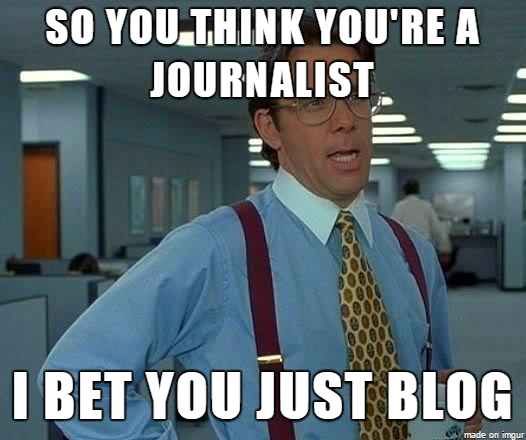
Annotated Bibliography
- Fashion History
This article provides a historiographical perspective on fashion as it explains fashion through the lens of world history. Not only does this article examines the evolution of trends but also provides explanation and example for the adaptation of the entire industry. For example, there is rare insight into the production, ideology of clothing, branding and merchandising. There is significant detail about individual designers within this historical timeline for further reference and understanding. As this source is found on the Business of Fashion website, as an educational tool, the source is well presented, informative and seemingly reliable.
2. 10 Simple Ways To Make Cheap Clothes Look Expensive
This ‘how to’ article sourced from Cosmopolitan’s online magazine was an enormously real and ‘everyday’ example of practical fashion. This article does not exist within the upper echelon of fashion blogging unlike other sources examined within this bibliography. Although highly simplistic in its format, this article is informative to our general inquiry in that it looks at the smaller things that exist in the fashion industry such as fit, ironing, washing and all things practical that is often silent in the discussions surrounding fashion.
3. The History behind Fashion’s Most Popular Trends
This source from the Refinery 29 newsletter is perhaps less ‘intellectual’ than some of the other sources however it exists as an insightful opinion piece regarding specific fashion trends and examples of their circular existence in the fashion world over the centuries. Providing photographic stories for 5 items of clothing, this article was helpful for a practical understanding for workable examples in my own digital artefact. It’s lack of intellectual capacity is of no consequence as we are concerned with individual opinion and style which is what fashion is fundamentally about.
4. ‘A Brief History of Women’s Fashion’
‘A Brief History of Women’s Fashion’ provides a photographic timeline of women’s fashion from the 1850’s to now. This article highlights the importance of fashion for the individual and their sense of self and identity. This is an interesting insight as it exemplifies the deep emotional connection that people (in this article, women) find in the process of choosing their outfits and what this means in a broader social context. Makers.com is women’s leadership platform so whilst it is useful in the deconstruction of women and their relationship with fashion however it is highly alienating of any male perspective to this topic.
5. 2016 streetwear trends
I found this article extremely helpful in that it was a direct example of the ‘voice of the people’ and their thoughts on current and potential future trends. In this discussion of fashion, there can often be complete saturation by the people working within the instiution. While I have mentioned the role of the bloggers as independent of this saturation, it is still important when moving away from high fashion and looking at streetwear that the everyday person and their taste, means of consumption, affordability etc are all acknowledged as well. Reddit provides a great platform for this and I found this fantastic for general knowledge and practical understanding.
6. Dress like a model for the party season:the labels they wear that you can actually buy
We could not create a digital artefact concerned with fashion if we did not examine the leading fashion and lifestyle magazine, Vogue. In terms of content, vogue online consist of predominantly photographs with minimal related wording. This is prevalent in the fashion section. This article attempts to provide examples of labels worn by celebrities that are affordable for the every day consumer. The price range of their examples were still quite considerable and I found this article to be somewhat alienating for anyone other than a wealthy socialite. The article was perhaps too scant for my liking but provided good photographic references.
7. Fashion Trends’ Impact on Society
Formatted as an essay, this article serves to highlight the important links between fashion and the greater workings of the world it exists in. Zegheanu places fashion within the broader context of society, the economy, policy and culture and examines the relationship between the manufacturer and producer and the loss of democratic principles within the industry. This article was extremely useful in providing an intellectual and conceptual background to fashion and the way that it has evolved. Additionally, the deconstruction of ‘trends’ as concept was invaluable information.
8. High-tops and high fashion: How sneakers rose from the street to chic
Honing in on a specific aspect of fashion, this article runs through the popularity of the sneaker shoe. Giving a shoe by shoe example of the journey of the sneaker, this article highlights interesting aspects of fashion such as the ‘era of the celebrity’. The notion of the cyclical nature of fashion is discussed as well as interesting examples of the multifaceted industry that exists outside the actual product. This article examines both shoe trends and purposes in a highly informative way. This article is useful in its specificity and of course as it is sourced from the CNN site it is highly reputable.
9. The Trends That Are Going To Be Big in 2016
For a pop culture interest, I included an article by Lauren Conrad (reality TV personality) to examine the relationship between a fashion blogger and the everyday consumer. The source of this article is the third largest online fashion platform ‘Who What Wear’, that prides itself on making “fashion approachable and style attainable”. Conrad’s article exists as a great example of the bridge between high fashion and fashion for the masses and was extremely informative in providing advice and links to affordable clothing. The website that the article is sourced from provides an overwhelming amount of information and links.
10. The 20 Most Influential personal Style Bloggers Right Now
The fashion world in the 21st century is overwhelmingly driven by ‘digital influences’ who have found to spark interest and subsequent brands and fashion houses in a revolutionary way. Specifically, we are concerned with bloggers and the blogosphere and their role as independent publishers in the fashion industry. This article provides a concise snapchat of the most relevant individuals that are driving and inspiring the fashion trends as we know or will know them. This article is saturated with hyperlinks which results in a wealth of information that I may subsequently sort through by relevance.
What do YOU prefer?
This soundcloud podcast briefly examines the nature of the apple vs android the debate through the ‘Rule of feel’ lense as dubbed by Alex Fitzpatrick. It is perhaps impossible to conclude on a definitive answer regarding what is ultimately the best form of technology as it appears to be a highly individualised decision.
Despite convergent media practices creating a flow of media across all sorts of platforms, people still engage with technology in a very personal manner. This directly affects the way in which people regard both Apple and Android and therefore their opinion on the subject.
The selfish truth behind copyright
In search of a dynamic conversation surrounding the nature of copyright and it’s place in society, I began scrolling through reddit. My conscience was immediately conflicted upon seeing the endless discourse of polarised opinion. This is not to say that people argued one way or another, as they didn’t. However as wide as the opposing opinions do go, there are a thousand different opinions in the middle of it.
I was surprised by this as the way that we discuss copyright today seems somewhat black and white. When we talk about the ‘golden years‘ of our civilisation, where intellectual thought and ideas flourished, this all occurred without the existence of copyright. In this light, copyright is regarded as Draconian in nature and at the very least restrictive.
However I am torn. I am torn between the difference in media platforms between now and afore mentioned, golden years. With the proliferation of media and its content, I feel myself become protective of content. I am of the opinion that the assumption of copyright, unless said otherwise, is a positive way forward. Yet, as a media and communication student, I am ashamed of this.
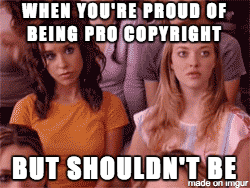
Kanye West and the Medium is the Message.
The way the world feels about Kanye West across all social media platforms is the way that I feel about Marshall McLuhan and his ‘message’… really, really confused. However if I use this meme as an example I can start to decipher the McLuhan code. The central tenet of this message is that every medium, despite it’s content, contains it’s own message.
What this means is that when we are examining the likes of a meme, we are digesting the visual information through the lens of what we understand a meme to be. A medium that is saturated with culture and relativity, a meme serves the function of quick, comedic and relevant sources of information. A meme is required by nature to have bolded text above the picture which serves the purpose of a witty social commentary.
Therefore, if we took this picture and examined it within the context of different media platforms, it becomes quite clear that the message does in fact change. Whilst Kayne West will always be a source of comedy, should we see this image in an art exhibition, would we not look upon this image with a seriousness that could not be found within a meme? Should you choose to continue this across all media platforms, I trust you will find a wide range of ‘feels’ in connection with this photo.
